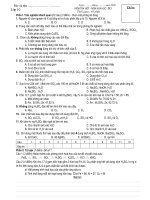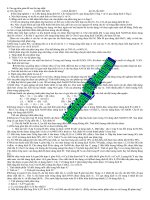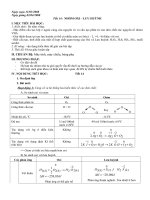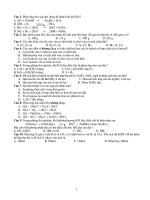Itˆo’s Formula
Bạn đang xem bản rút gọn của tài liệu. Xem và tải ngay bản đầy đủ của tài liệu tại đây (136.38 KB, 10 trang )
Chapter 15
It
ˆ
o’s Formula
15.1 It
ˆ
o’s formula for one Brownian motion
We want a rule to “differentiate” expressions of the form
f B t
,where
f x
is a differentiable
function. If
B t
were also differentiable, then the ordinary chain rule would give
d
dt
f B t = f
0
B tB
0
t;
which could be written in differential notation as
df B t = f
0
B tB
0
t dt
= f
0
B tdB t
However,
B t
is not differentiable, and in particular has nonzero quadratic variation, so the correct
formula has an extra term, namely,
df B t = f
0
B t dB t+
1
2
f
00
Bt dt
|z
dB t dB t
:
This is Itˆo’s formula in differential form. Integrating this, we obtain Itˆo’s formula in integral form:
f B t , f B 0
| z
f 0
=
Z
t
0
f
0
B u dB u+
1
2
Z
t
0
f
00
B u du:
Remark 15.1 (Differential vs. Integral Forms) The mathematically meaningful form of Itˆo’s for-
mula is Itˆo’s formula in integral form:
f B t , f B 0 =
Z
t
0
f
0
B u dB u+
1
2
Z
t
0
f
00
B u du:
167
168
This is because we have solid definitions for both integrals appearing on the right-hand side. The
first,
Z
t
0
f
0
B u dB u
is an Itˆointegral, defined in the previous chapter. The second,
Z
t
0
f
00
B u du;
is a Riemann integral, the type used in freshman calculus.
For paper and pencil computations, the more convenient form of Itˆo’s rule is Itˆo’s formula in differ-
ential form:
df B t = f
0
B t dB t+
1
2
f
00
B t dt:
There is an intuitive meaning but no solid definition for the terms
df B t;dBt
and
dt
appearing
in this formula. This formula becomes mathematically respectable only after we integrate it.
15.2 Derivation of It
ˆ
o’s formula
Consider
f x=
1
2
x
2
,sothat
f
0
x=x; f
00
x=1:
Let
x
k
;x
k+1
be numbers. Taylor’s formula implies
f x
k+1
, f x
k
=x
k+1
, x
k
f
0
x
k
+
1
2
x
k+1
, x
k
2
f
00
x
k
:
In this case, Taylor’s formula to second order is exact because
f
is a quadratic function.
In the general case, the above equation is only approximate, and the error is of the order of
x
k+1
,
x
k
3
. The total error will have limit zero in the last step of the following argument.
Fix
T0
and let
=ft
0
;t
1
;::: ;t
n
g
be a partition of
0;T
. Using Taylor’s formula, we write:
f B T , f B 0
=
1
2
B
2
T ,
1
2
B
2
0
=
n,1
X
k=0
f B t
k+1
, f B t
k
=
n,1
X
k=0
B t
k+1
, B t
k
f
0
B t
k
+
1
2
n,1
X
k=0
B t
k+1
, B t
k
2
f
00
B t
k
=
n,1
X
k=0
B t
k
Bt
k+1
, B t
k
+
1
2
n,1
X
k=0
B t
k+1
, B t
k
2
:
CHAPTER 15. Itˆo’s Formula
169
We let
jjjj!0
to obtain
f B T , f B 0 =
Z
T
0
B u dB u+
1
2
hBiT
| z
T
=
Z
T
0
f
0
B u dB u+
1
2
Z
T
0
f
00
B u
| z
1
du:
This is Itˆo’s formula in integral form for the special case
f x=
1
2
x
2
:
15.3 Geometric Brownian motion
Definition 15.1 (Geometric Brownian Motion) Geometric Brownian motion is
S t=S0 exp
n
Bt+
,
1
2
2
t
o
;
where
and
0
are constant.
Define
f t; x=S0 exp
n
x +
,
1
2
2
t
o
;
so
S t=ft; B t:
Then
f
t
=
,
1
2
2
f; f
x
= f; f
xx
=
2
f:
According to Itˆo’s formula,
dS t= dft; B t
= f
t
dt + f
x
dB +
1
2
f
xx
dB dB
| z
dt
=,
1
2
2
fdt+f dB +
1
2
2
fdt
=S tdt + St dB t
Thus, Geometric Brownian motion in differential form is
dS t= S tdt + St dB t;
and Geometric Brownian motion in integral form is
S t=S0 +
Z
t
0
S u du +
Z
t
0
Su dB u:
170
15.4 Quadratic variation of geometric Brownian motion
In the integral form of Geometric Brownian motion,
S t=S0 +
Z
t
0
S u du +
Z
t
0
S u dB u;
the Riemann integral
F t=
Z
t
0
S u du
is differentiable with
F
0
t=S t
. This term has zero quadratic variation. The Itˆointegral
Gt=
Z
t
0
Su dB u
is not differentiable. It has quadratic variation
hGit=
Z
t
0
2
S
2
udu:
Thus the quadratic variation of
S
is given by the quadratic variation of
G
. In differential notation,
we write
dS t dS t= S tdt + StdB t
2
=
2
S
2
t dt
15.5 Volatility of Geometric Brownian motion
Fix
0 T
1
T
2
.Let
=ft
0
;::: ;t
n
g
be a partition of
T
1
;T
2
.Thesquared absolute sample
volatility of
S
on
T
1
;T
2
is
1
T
2
, T
1
n,1
X
k=0
S t
k+1
, S t
k
2
'
1
T
2
, T
1
T
2
Z
T
1
2
S
2
u du
'
2
S
2
T
1
As
T
2
T
1
, the above approximation becomes exact. In other words, the instantaneous relative
volatility of
S
is
2
. This is usually called simply the volatility of
S
.
15.6 First derivation of the Black-Scholes formula
Wealth of an investor. An investor begins with nonrandom initial wealth
X
0
and at each time
t
,
holds
t
shares of stock. Stock is modelled by a geometric Brownian motion:
dS t= S tdt + S tdBt:
CHAPTER 15. Itˆo’s Formula
171
t
can be random, but must be adapted. The investor finances his investing by borrowing or
lending at interest rate
r
.
Let
X t
denote the wealth of the investor at time
t
.Then
dX t= tdS t+rXt, tS t dt
=tS tdt + StdB t + r X t , tS t dt
= rX tdt +tSt,r
| z
Risk premium
dt +tStdB t:
Value of an option. Consider an European option which pays
g S T
at time
T
.Let
v t; x
denote
the value of this option at time
t
if the stock price is
S t=x
. In other words, the value of the
option at each time
t 2 0;T
is
v t; S t:
The differential of this value is
dv t; S t = v
t
dt + v
x
dS +
1
2
v
xx
dS dS
= v
t
dt + v
x
S dt + S dB+
1
2
v
xx
2
S
2
dt
=
h
v
t
+ S v
x
+
1
2
2
S
2
v
xx
i
dt + Sv
x
dB
A hedging portfolio starts with some initial wealth
X
0
and invests so that the wealth
X t
at each
time tracks
v t; S t
. We saw above that
dX t= rX +,rS dt + SdB:
To ensure that
X t=vt; S t
for all
t
, we equate coefficients in their differentials. Equating the
dB
coefficients, we obtain the
-hedging rule:
t=v
x
t; S t:
Equating the
dt
coefficients, we obtain:
v
t
+ S v
x
+
1
2
2
S
2
v
xx
= rX +,rS:
Butwehaveset
=v
x
, and we are seeking to cause
X
to agree with
v
. Making these substitutions,
we obtain
v
t
+ S v
x
+
1
2
2
S
2
v
xx
= rv + v
x
, rS;
(where
v = v t; S t
and
S = S t
) which simplifies to
v
t
+ rS v
x
+
1
2
2
S
2
v
xx
= rv:
In conclusion, we should let
v
be the solution to the Black-Scholes partial differential equation
v
t
t; x+rxv
x
t; x+
1
2
2
x
2
v
xx
t; x=rv t; x
satisfying the terminal condition
v T; x= gx:
If an investor starts with
X
0
= v 0;S0
and uses the hedge
t=v
x
t; S t
, then he will have
X t=vt; S t
for all
t
, and in particular,
X T = gST
.









